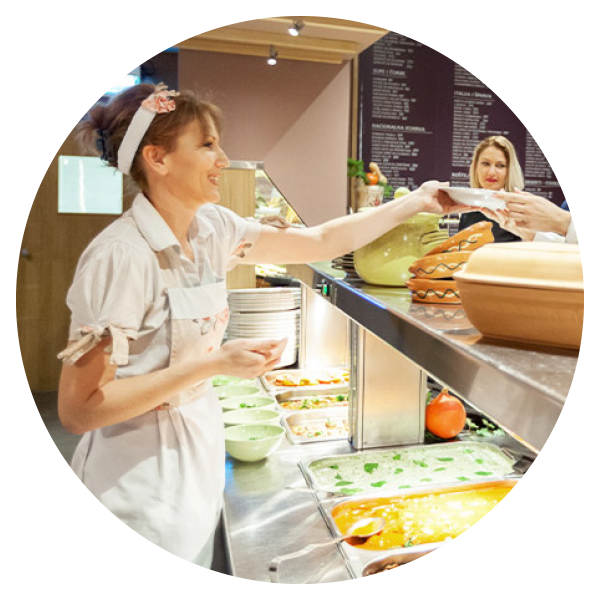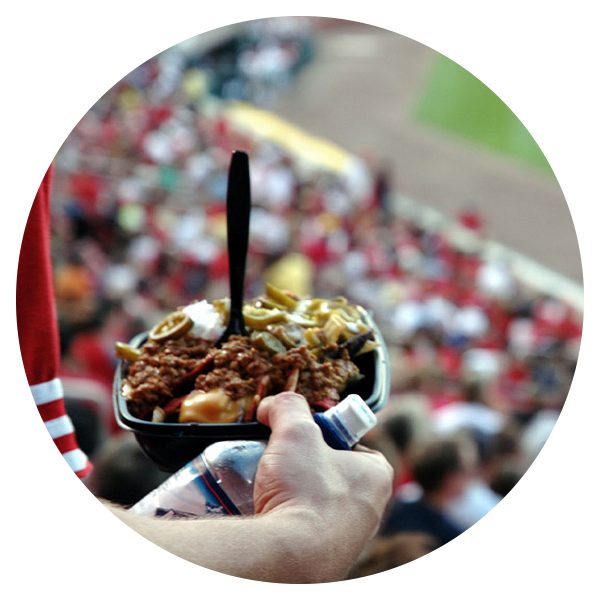TYSON FOODS, INC. TRADEMARKS AND REGISTERED TRADEMARKS ARE OWNED BY TYSON FOODS, INC. OR ITS SUBSIDIARIES.
Philly works hard—for any kind of kitchen, clientele, menu or budget.
Lean into smart protein solutions that help enterprising operators drive revenue, margins and competitive differentiation—from a food truck feeding 100 customers a day to a national chain serving thousands every hour.

Full Service Restaurant (FSR)
Kitchen:
Often fully equipped with cooktop grills, fryers, pizza ovens, stoves, microwaves & other equipment for preparing hot foods
Staff:
Skills & experience varies; from seasoned professionals to young, part-time workers
Top Sellers:
• BreakAway® Pucks
• Flat Steaks
FSRs offer table service with waiters/waitresses serving meals that are cooked to order. These establishments range from regional and national chains to local establishments like cafes and even diners and bars.
FSRs are known for having deep, diverse menus. From no-frills, economical meals to fine dining, with a lot of variation in between, FSRs often cater to traditional lunch and dinner crowds, sometimes offering breakfast/brunch and/or late-night eats. While they strive for consistent dine-in traffic, many also enjoy robust take-out business. Regardless of the day parts, price profile, or menu concept—classic “American fare;” globally-inspired orientations like Mexican, Chinese, Indian, and Italian; specialities like steakhouses and seafood; and so on—Sliced Philly beef and chicken can expand and elevate menus for these restaurants and their customers.
Due to the variety of menu items, kitchen staff are generally counted on to simultaneously manage multiple orders and cooking stations. FSRs typically have full kitchens including cooktop grills, fryers, pizza ovens, stoves, microwaves, and other equipment for preparing hot foods. Of course, with varied menus, there are also cold dishes—salads, sandwiches, and so on—plus sides, drinks, desserts, and more which need to be prepped by the back-of-house staff.
Whether it’s a popular chain restaurant promoting loaded nachos, an upscale steakhouse serving gourmet cheesesteak egg roll appetizers with Sriracha ketchup, or a favorite local brew pub featuring spicy chicken quesadillas for happy hour, the FSR segment represents a wide assortment of eateries—and a huge opportunity for Philly products.

Quick Service Restaurant (QSR)
Kitchen:
Typically well equipped with cooktop grills, fryers, ovens, microwaves & other equipment for preparing hot foods, as well as heating lamps to keep queues warm
Staff:
Full- & part-time, often hourly-wage employees with varying levels of experience
Top Sellers:
• Fast BreakAway® Slices
• Flat Steaks
• Fully Cooked
QSRs are eateries that are known for convenience and affordability. They’re typically counter service (or self-service kiosks) with menu items that can be produced with speed—in some cases ready-made, others made-to-order.
Often medium or large chains offering dine-in, carryout/drive-through, and/or delivery, QSRs include sandwich outfits and franchises, local pizza shops and delivery giants, and fast food restaurants. In addition to core, everyday menu items, these operations may feature special seasonal items along with occasional tests and/or limited time offerings (aka LTOs).
As the name of the segment suggests, speed is a key characteristic. Kitchens are churning out meals for a wide range of customers, all expecting to get their food without much waiting. For this reason, the Fast BreakAway® Slices and Flat Steaks—both which go from raw to cooked in about a minute-and-a-half on the grill—are popular products for QSR operators. And for QSR environments that do not have full kitchens or cooking capabilities (equipment and/or skills/training), fully cooked beef and chicken are effective scoop-and-serve options for sandwiches, salads, pizzas, shareables, and snacks. Regardless of product format, speed can be achieved without compromising quality, consistency, flavor, or margins.

Owners & Operators
Kitchen:
Ranges from large & fully equipped to extremely basic/modest; many (but not all) have flat top grills
Staff:
Skilled but low personnel numbers (typically up to a handful of cooks); minimal need for education/training due to high familiarity with product
Top Sellers:
• Flat Steaks
• Fully Cooked
Locally owned and managed foodservice businesses come in all shapes and sizes—pizza and sandwich shops, delis, burger joints, diners, bars, cafes, and more. These operations are truly local—serving neighborhoods and communities, often relying on repeat business and close-knit relationships with their customers. They’re found in densely populated cities, suburban shopping centers and office parks, malls, quiet rural areas, and literally everywhere in between.
Depending on the concept, size and locations, customer profile, plus other factors, some of these establishments serve a predominantly eat-in constituency, while others are built around significant carryout and/or delivery business. Similarly, the attributes of each entity may influence how menu items are developed and priced.
Given their independent ownership and management, the restaurant and menu concepts vary greatly. Some are limited in their focus, such as pizzerias and taquerias; others offer extensive menus including traditional breakfast items, a host of lunch options, and deep dinner offerings. And then there are globally-inspired establishments, reflecting a proprietor’s own background, neighborhood and clientele, and/or strategic business angle. Philly products offer versatile, economical, and widely desirable proteins that can augment menus as center-of-plate features, creative recipe ingredients, and optional add-ons for customers.

Convenience Stores
Kitchen:
Primarily microwaves for cooking/ heating
Staff:
High numbers of store personnel; not highly skilled or trained, with various responsibilities
Top Sellers:
• Fully Cooked
C-Stores are named for convenience—so their main focus is the grab-and-go market. The C-Store segment is dominated by large grocery and/or gasoline chains offering hot breakfast and lunch sandwiches, as well as chains/stores with deli counters, serving cheesesteaks along with other meals and snacks. Smaller, local franchises and single-location shops/markets round out the space.
Menu items at these outfits are typically limited to simple offerings that can be prepped (and consumed) with relative ease and speed. For instances where food is not cooked to order—which covers the majority of C-Store applications—items that can be prepared, wrapped, and kept warm and fresh to achieve several-hour shelf-life are ideal.
Kitchens also tend to be limited at these locations, in terms of both tools and staffing. For items needing cooking and heating, microwaves are the go-to source, as most do not have the equipment or skills for grill top cooking. Still, despite the streamlined capabilities, quality and consistency across stores is critical to the large chain businesses. For all of these reasons, fully cooked beef and chicken products are the most popular.

Non-Commercial
Kitchen:
Flat top grill; steam tables
Staff:
Skilled, high numbers of staff; training needed in the beginning
Top Sellers:
• BreakAway® Pucks
• Flat Steaks
• Fully Cooked
The Non-Comm segment is typically cafeteria-style foodservice applications serving large numbers/groups of people. These include hospitals, schools, corporate complexes, and other campus-like environments. Menu selections tend to cover a wide range of categories/types, but are generally less robust than FSRs, and food is typically prepared in large quantities.
The Colleges and Universities (C&U) sub-set ranges from small, private institutions, to the largest higher ed campuses, and even community and specialty schools with localized student bodies and faculties that offer dining. Business and Industry (B&I) includes any foodservice installation serving centralized employee bases (often welcoming other walk-in customers, as well), whether they work for one large organization or a collection of businesses sharing a common facility. Healthcare consists of cafeterias serving patients, visitors, medical staff, and administrators in hospitals, treatment centers, senior/assisted living complexes, and similar care-oriented venues.
In all instances, the kitchens are preparing on-site meals and snacks to support the core function and its constituencies, as opposed to selling food as the profit center of the operation. They’re often serving a wide range of menu items/applications, generally in high-volume settings, with speed and value prioritized over quality, creativity, or flavor. Still, sliced Philly products offer easy, versatile, hearty, and popular menu items—for featured meal items like cheesesteaks and other sandwiches, as well as noodle and/or rice bowls, plus less conventional recipes like beef or chicken over salads, in omelets, on fries and nachos, and more.

Recreation
Kitchen:
Flat top grill; steam tables
Staff:
High numbers of staff with basic skills/experience
Top Sellers:
• Flat Steaks
• Fully Cooked
Recreation covers counter-service and sit-down eateries at large sports stadiums and arenas, amusement parks, ski resorts, and general entertainment complexes, as well as smaller foodservice concessions at movie theaters, bowling alleys, even country clubs and camps. More specifically, it’s your cheesesteaks, chicken quesadillas and steak nachos, and gourmet pizzas and salads served at ballparks and theme parks, all the way to community golf courses and swim clubs.
Particularly with the larger operations, the kitchens are staffed in very large numbers, often with employees who may not have a lot of experience in their roles. Still, the major entertainment enterprises have high quality standards, aiming to be efficient, high-volume, quick-turn operations. On the other end of the spectrum—e.g., a snack bar at a local pool—there are far fewer workers, tending to have more prep training than culinary talent, and serving lower volume demands.
Many of these businesses are seasonally driven, which affects ordering/quantity, as well as the staff they maintain to serve their customers. In the larger environments, it’s often highly competitive, as there are other food choices in the vicinity.
